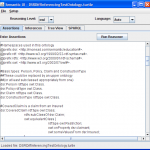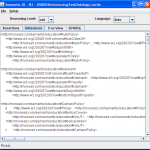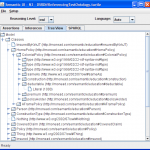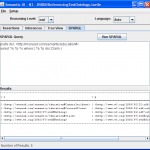Semantic Technology and Business Conference, East 2011 – Reflections
Wednesday, December 7th, 2011I had the pleasure of attending the Semantic Technology and Business Conference in Washington, DC last week. I have a strong interest in semantic technology and its capabilities to enhance the way in which we leverage information systems. There was a good selection of topics discussed by people with a variety of backgrounds working in different verticals.
To begin the conference I attended the half day “Ontology 101” presented by Elisa Kendall and Deborah McGuinness. They indicated that this presentation has been given at each semantic technology conference and the interest is still strong. The implication being that new people continue to want to understand this art.
Their material was very useful and if you are someone looking to get a grounding in ontologies (what are they? how do you go about creating them?) I recommend attending this session the next time it is offered. Both leaders clearly have deep experience and expertise in this field. Also, the discussion was not tied to a technology (e.g. RDF) so it was applicable regardless of underlying implementation details.
I wrapped up the first day with Richard Ordowich who discussed the process of reverse engineering semantics (meaning) from legacy data. The goal of such projects being to achieve a data harmonization of information across the enterprise.
A point he stressed was that a business really needs to be ready to start such a journey. This type of work is very hard and very time consuming. It requires an enterprise wide discipline. He suggests that before working with a company on such an initiative one should ask for examples of prior enterprise program success (e.g. something like BPM, SDLC).
Fundamentally, a project that seeks to harmonize the meaning of data across an enterprise requires organization readiness to go beyond project execution. The enterprise must put effective governance in place to operate and maintain the resulting ontologies, taxonomies and metadata.
The full conference kicked off the following day. One aspect that jumped out for me was that a lot of the presentations dealt with government-related projects. This could have been a side-effect of the conference being held in Washington, DC but I think it is more indicative that spending in this technology is more heavily weighted to public rather than private industry.
Being government-centric I found any claims of “value” suspect. A project can be valuable, or show value, without being cost effective. Commercial businesses have gone bankrupt even though they delivered value to their customers. More exposure of positive-ROI commercial projects will be important to help accelerate the adoption of these technologies.
Other than the financial aspect, the presentations were incredibly valuable in terms of presenting lessons learned, best practices and in-depth tool discussions. I’ll highlight a few of the sessions and key thoughts that I believe will assist as we continue to apply semantic technology to business system challenges.
 The semantic technology concepts that comprise what is generally called the semantic web involve paradigm shifts in the ways that we represent data, organize information and compute results. Such shifts create opportunities and present challenges. The opportunities include easier correlation of decentralized information, flexible data relationships and reduced data storage entropy. The challenges include new data management technology, new syntaxes, and a new separation of data and its relationships.
The semantic technology concepts that comprise what is generally called the semantic web involve paradigm shifts in the ways that we represent data, organize information and compute results. Such shifts create opportunities and present challenges. The opportunities include easier correlation of decentralized information, flexible data relationships and reduced data storage entropy. The challenges include new data management technology, new syntaxes, and a new separation of data and its relationships.



